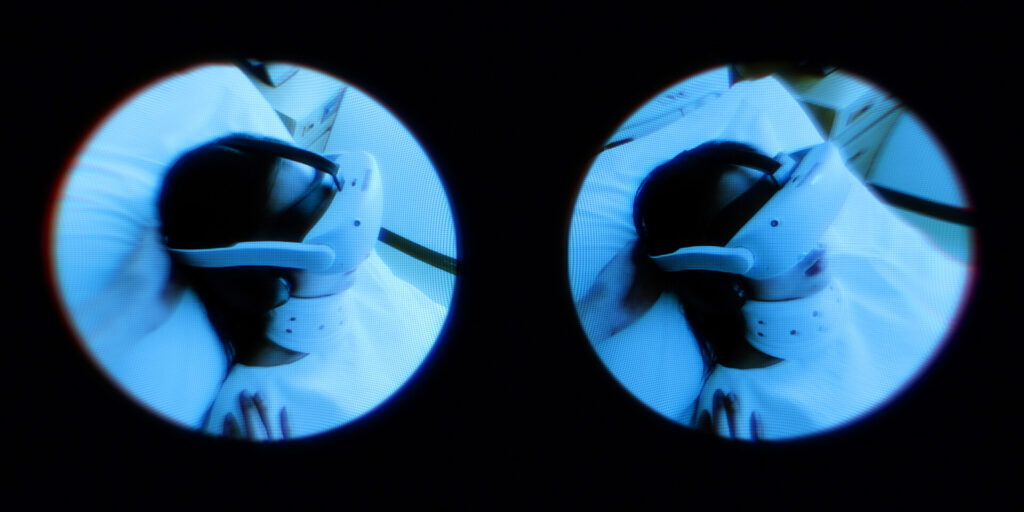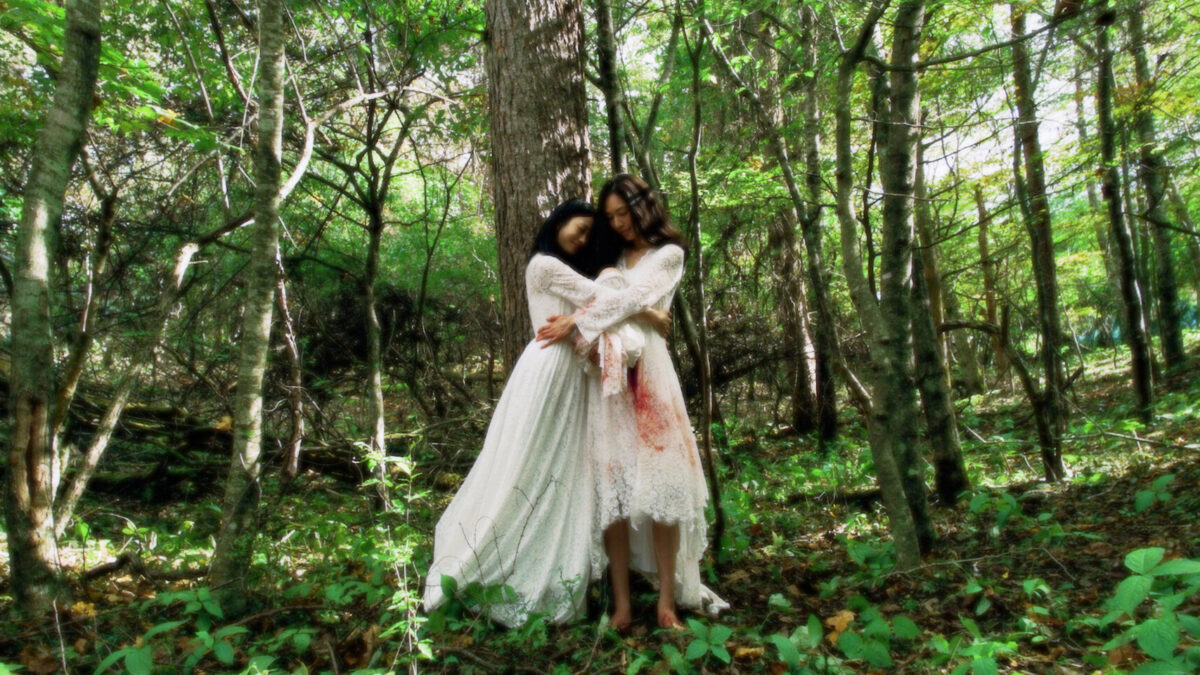Op vrijdag 3 november kan je op Razor Reel Flanders Film Fest het dromerige My Mother’s Eyes bekijken. In de film schenkt een moeder haar leven aan haar verlamde dochter met behulp van hoog technologische lenzen en een VR Set. Fast Forward kreeg de kans om regisseur Takeshi Kushida kort een aantal vragen te stellen.
My Mother’s Eyes is een complexe film, niet alleen qua subtekst en symboliek, maar ook qua boodschap. Wat was je creatieve proces om hiertoe te komen?
Na de internationale release van mijn debuutfilm Woman of the Photographs, merkte ik dat veel mensen zichzelf herkennen in de “onzekerheid van identiteit door technologische vooruitgang”. Daarom wilde ik dit thema voortzetten in mijn tweede film.
Het idee voor My Mother’s Eyes kwam van een artikel uit Science over de ontwikkeling van slimme contactlenzen. Ik was gefascineerd door het idee dat wat een mens ziet, wordt opgenomen als een video. De contactlenzen met ingebouwde camera zouden in 2023 uitkomen. Helaas is de release vertraagd door financiële problemen bij het ontwikkelingsbedrijf, maar over een paar jaar zouden we de lenzen in onze handen kunnen hebben.
Ik probeer met My Mother’s Eyes een voorspelling te maken van de toekomst.

De hoofdpersonages in de film zijn cellisten. Ben je zelf een muziekliefhebber? Wat kunnen we verwachten in jouw Spotify-lijst?
Ik hou van muziek. En vooral van strijkinstrumenten omdat het verschillende timbres en dynamieken kan uitdrukken, wat een piano bijvoorbeeld niet kan. Hierdoor voel ik de sensualiteit van de muziek. Mijn favoriete componist is Toru Takemitsu, de legendarische Japanse componist. Zijn muziek in de films van Hiroshi Teshigahara is prachtig.
Zonder veel weg te geven: in My Mother’s Eyes ben je niet bang om een onderwerp aan te snijden die vaak als taboe wordt gezien. Welke reacties kreeg je hierop?
Een vriend van me kwam naar de film met zijn zwangere vrouw. Na de vertoning zei ze tegen me dat de meest angstaanjagende scène niet de splatterscène is, maar het gesprek tussen de moeder en dochter vóór het auto-ongeluk. Misschien was ze bang dat moeders geen “onvoorwaardelijke liefde” hebben voor hun kind en dat dit alleen mogelijk is door opoffering en krankzinnigheid van de moeder.

My Mother’s Eyes is ondertussen je tweede speelfilm. Wat heb je geleerd van je werk aan je vorige film en hoe heb je dat toegepast?
Ik heb veel geleerd over promotiestrategie van mijn eerste speelfilm. Daarom begon ik in My Mother’s Eyes met het visuele gedeelte voordat de film werd opgenomen. Met een geweldige bijdrage van de ontwerpers en retoucheurs konden we een geweldige poster maken!
Ook typerend voor jouw films is de dromerige sfeer. Dit is iets wat je jezelf hebt meester gemaakt in My Mother’s Eyes. Welke werken/filmmakers hebben de grootste invloed gehad op jouw dromerige stijl?
De films van Satoshi Kon zijn allemaal invloedrijk voor mij. Ik heb de fragiliteit van de realiteit uit zijn films geleerd. Zijn eerste speelfilm Perfect Blue (1997) werd onlangs heruitgebracht in Japanse bioscopen, en de zaal was overvol. Ik denk dat moderne mensen sympathie kunnen opbrengen voor zijn realiteit- en illusiegecombineerde kijk op de wereld.
Tot slot: Dit is een vraag die ik jou absoluut wilde stellen na het zien van de film: hoe drink jij je espresso het liefst?
Met veel suiker. Daar word ik blij van.
ENGLISH VERSION:
My Mother’s Eyes is a complex film, not only in its subtext and symbolism, but also in its message. What was your creative process to arrive at this?
After the international release of my debut Woman of the Photographs, I noticed that many people sympathize with the “uncertainty of identity due to technological progress.” So I wanted to continue this theme in my second film.
The idea for My Mother’s Eyes came from an article in Science on the development of smart contact lenses. I was fascinated by the idea that what a person sees is recorded as a video. The contact lens with built-in camera was supposed to be released in 2023. Unfortunately, the release has been delayed due to financial problems at the development company, but in a few years we should have the lenses in our hands.
I am trying to make a prediction of the future with My Mother’s Eyes.
The main characters in the film are cellists. Are you a music lover yourself? What can we expect to see in your Spotify list?
I love music. And especially string instruments, because it can express different timbres and dynamics, which a piano cannot. Because of this, I feel the sensuality of music. My favorite composer is Toru Takemitsu, the legendary Japanese composer. His music in Hiroshi Teshigahara’s films is beautiful.
Without giving much away. In My Mother’s Eyes, you are not afraid to address a subject that is often seen as taboo. What reactions did you get to this?
A friend of mine came to the film with his pregnant wife. After the screening, she said to me that the most frightening scene is not the splatter scene, but the conversation between the mother and daughter before the car accident. Perhaps she was afraid that mothers do not have “unconditional love” for their child and that this is only possible through sacrifice and insanity on the part of the mother.
My Mother’s Eyes, meanwhile, is your second feature film. What did you learn from your work on your previous film and how did you apply it?
I learned a lot about promotional strategy from my first feature film. So in My Mother’s Eyes, I started with the visual part before the film was shot. With a great contribution from the designers and retouchers, we were able to make a great poster!
Also typical of your films is the dreamy atmosphere. This is something you mastered yourself in My Mother’s Eyes. Which works/filmmakers have had the greatest influence on your dreamy style?
Satoshi Kon’s films are all influential for me. I learned the fragility of reality from his films. His first feature film Perfect Blue (1997) was recently rereleased in Japanese cinemas, and the cinema was packed. I think modern people can sympathize with his reality- and illusion-combined view of the world.
In conclusion, here’s a question I absolutely wanted to ask you after seeing the movie: how do you prefer your espresso?
With plenty of sugar. It makes me happy.








